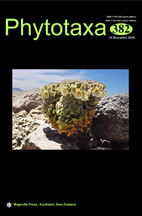Abstract
Corydalis ternatifolia (Papaveraceae), a perennial herb endemic to China, shares morphological similarities with both C. sect. Incisae and C. sect. Asterostigmata, rendering its taxonomic position controversial. In this study, we carried out a detailed morphological comparison of C. ternatifolia with the related species and conducted a phylogenetic analysis of C. ternatifolia and five species from C. sect. Incisae, three species from C. sect. Asterostigmata (including the type species of these two sections), and additional 21 species of Corydalis from 10 other sections. To reconstruct the phylogenetic relationships, sequences of the nuclear NADPH gene and chloroplast DNA (matK gene + trnG intron) were analyzed using Bayesian inference and maximum parsimony. The resulting four phylogenetic trees shared almost identical topology and resolved C. ternatifolia within C. sect. Asterostigmata with strong support. Our results suggested that C. ternatifolia belongs to the C. sect. Asterostigmata. This study has demonstrated that molecular evidence is effective in resolving the sectional placement of Corydalis species with elusive taxonomic position.

